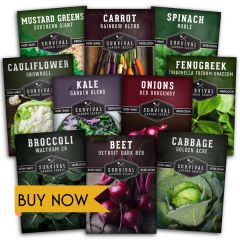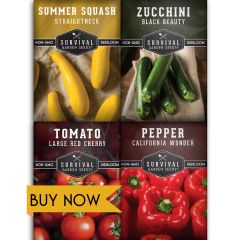How Soon Can You Plant Seeds in Springtime?
Last year, we started to do a monthly series of guides, starting around this time of year with “Vegetables You Can Sow in March”. As we listened to your feedback, we discovered that when you’re talking to hundreds of gardeners from very different climates, it can be a challenge to answer this question for every crop and every person. However, you can definitely get started growing by planting at least some type of seed almost any time of year – even if it’s just microgreens or an indoor herb garden.
William DeMille recently addressed this topic in a weekly Q&A session. He suggests dividing your crops into two broad categories: Warm Season & Cool Season. This can simplify your planting schedule and help you figure out what to get started, and when. It also helps you figure out when you’ll be hardening off your plants and moving them to their permanent outdoor home.
Warm Season Crops
If the plant is tender, meaning frost or even cool weather causes the plant to die, then it’s a warm-season crop. These plants should be grown in spring, summer, and fall, when they’re not going to die. If you live in a tropical zone where it never gets cold, you might even be able to grow these plants all year round. However, if you have real winters with killing frosts, warm season crops won’t make it through the winter. Makes sense, right? Many of these plants will shut down even if night temperatures are around 50°F or so. That can also make growing these crops a challenge in high altitudes because of nighttime temps.
William gives us a list of these warm-season crops as a general guideline. He suggests starting these seeds inside 6-8 weeks before your last spring frost date. This gives them a head start to extend your growing season. You’ll transplant them outdoors after soil temperatures warm and you’re sure it’s not going to freeze at night.
- Tomatoes
- Peppers
- Cucumbers
- Eggplants
- Sweet potatoes
- Melons
- Squash (both winter and summer varieties!)
- Basil
- Turmeric
- Ginger
Cool Season Crops
These crops are generally good to grow in spring, fall, and winter. Just as some climates can grow warm season crops all year round, cooler climates (or high elevation) might be able to grow these crops all year round, too. But if your summers are very hot, you may find that these plants bolt, become bitter, or even die in summer’s heat. You can start these indoors 8-10 weeks before your last frost date. Since these can handle some light frost, you can move them outside a little earlier than warm-season crops. Cover them to protect them during brief cold snaps and they’ll be okay.
- Broccoli
- Cabbage
- Onion
- Potatoes
- Carrots
- Brussels Sprouts
- Lettuce
- Spinach (for summer, try our heat-loving alternative, New Zealand Spinach)
- Cilantro
If you’re not able to grow a crop outdoors all year round, greenhouses or indoor hydroponic systems can extend your growing season by providing shelter from extreme temperatures.
We hope this helps you have a general idea of how to plan your seed planting calendar. Using the USDA Hardiness Zone Map can help you get an idea of your last frost date, so check out our guide to understanding your zone. Remember that microclimates and growing conditions can still vary widely between zones. It’s always a great idea to talk with other local gardeners about what works best in your area. And if all else fails, experiment! Seeds are an inexpensive option for growing your own vegetables, herbs, and flowers, and can help you learn far more about what works best for you. A packet of seeds often costs less than just one seedling!


























